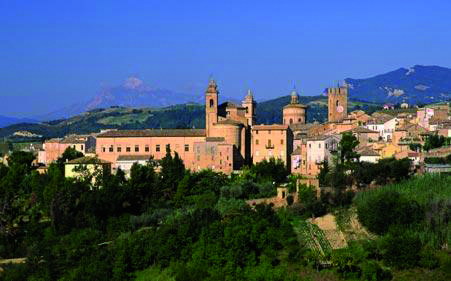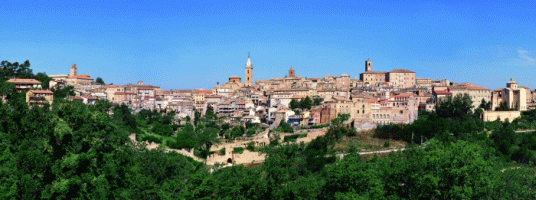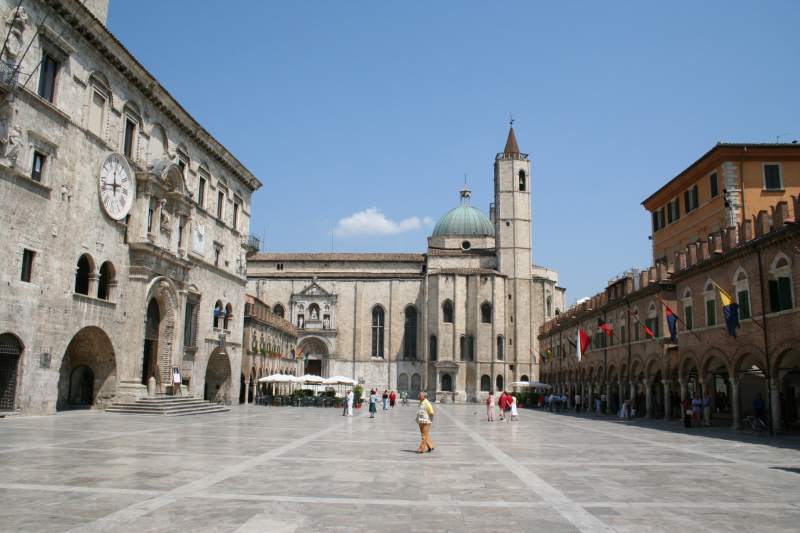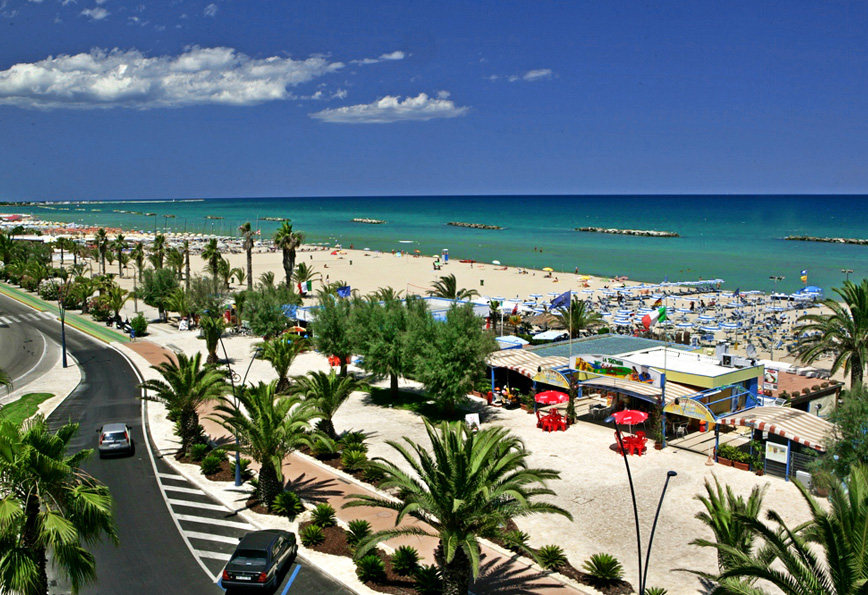OFFIDA

The Town Hall (11th-12th century), one of the most beautiful in the Region, shows in its splendid façade a row of suggestive swallowtail battlements. Looking up, the clock tower, today respectful in its beauty, was once used by the people of Offida also as a prison for those condemned to death. The elegant fifteenth-century portico located on the ground floor, and the upper loggia supported by a row of travertine columns on the first floor, complete the façade of the Town Hall. Not far from the town, imposing and proud, surrounded by a magical atmosphere, austere custodian of the secrets and virtues of this town, the Church of S. Maria della Rocca is tangible proof of the elegance and splendor of which the Benedictine monks they surrounded each other. In Romanesque-Gothic style, it is the most significant monument from an architectural point of view. It was built in 1330 on the foundations of a Lombard castle.
THE OFFIDA CARNIVAL
Offida shows its more playful and wild side in the carnival celebrations. The Offida carnival has something sacred, perhaps mystical, in how it is felt and experienced by the people of Offida. Preparing for the carnival means preparing for a ritual, entering into a state of mind that accompanies the people of Offida not only when they wear the “guazzarò”, the typical carnival costume, but long before. There are two more folkloristic events, “Lu Bov Fint” which is celebrated on Shrove Friday, and the “Vlurd”, which is celebrated on Shrove Tuesday.
BOBBIN LACE
Offida, placid in its squares and among its churches, preserves and passes on, in the shade of the alleys, on the doors of the houses in spring, in the admirable skill of its women, the ancient tradition of bobbin lace making.
RIPATRANSONE

To this splendid village, perched above the hills, in the 16th century. it was given the nickname “bulwark of the Piceno”, due to the fact that its particular position made it an exceptional watchtower as well as an almost inaccessible place. The Town Hall, imposing in its beautiful structure, was built in the century. XIII, completely rebuilt in the century. XVII today houses the Library and the Archaeological Museum, which houses more than three thousand pieces. The Civic Art Gallery is located inside Palazzo Bonomi-Gera and hosts artists from different eras, with works by contemporaries such as Pericle Fazzini and Arnoldo Ciarrocchi and paintings on wood by Vittore Crivelli (15th century) or Vincenzo Pagani.
The Fire Horse
The centuries-old history of the inhabitants of this town is celebrated every year with one of the oldest fireworks displays in Italy, the Fire Horse, whose origins date back to 1682, when it was celebrated for the first time on May 10th, the of the coronation of the Madonna of S. Giovanni. In the town, on the first Sunday after Easter, a horse made of sheet metal is led on which beautiful fireworks are placed: when the skilled hands of the stokers start the show, the fiery horse is made to turn around Piazza Condivi and under the Cathedral, giving exciting moments not only for all the Ripani but also for the crowds of tourists who over the years increasingly flock to the long-awaited event.
ASCOLI PICENO

Ascoli is always a surprise, an unexpected encounter. Wonder is the most common feeling experienced by those who for the first time pass its gates, its bridges to enter the city of a hundred towers. The origins of the city are very remote, the people of Ascoli like to say they are older than Rome, and it is probably true if you consider that a first settlement could have been that of young Sabines coming from Lazio, guided on their journey by a woodpecker, a sacred bird to Mars. Piceno would be the etymological derivation of Picus, meaning woodpecker. The symbol of Ascoli is in fact the woodpecker.
One piece of advice we give you is to start your visit from Piazza Arringo, in ancient times popular assemblies were held in the square, and its name is probably due to this.
A few meters from Piazza Arringo you will find Piazza del Popolo, the beauty of the square makes it one of the most evocative in Italy. The local stone dominates in it, that white travertine that time makes unique. And so, the imposing facade of the Palazzo dei Capitani shows its best next to the refined Caffè Meletti, all ornate and shining. This square is a game of references, from one century to another, from one story to another, just focus on the mullioned windows, on a walled plaque that preserves an inscription. You enter the square and address them on first terms, you turn and turn, you look around, curious and enraptured, until you understand that the proportions, the backgrounds, the openings, the views, are there for you and you for them, so for in an instant time is no longer time, but something similar to a hug. Historic city center, meeting place and charm, Piazza del Popolo owes its current architectural homogeneity to a far-sighted and unitary project for the reorganization of the space implemented in the sixteenth century, the century of divine proportions which replaced a pre-existing non-uniform agglomeration of huts and artisan workshops.
SAN BENEDETTO DEL TRONTO

In the current configuration of the provincial territory, San Benedetto is an economic center of primary importance and the second urban center after that of Ascoli Piceno. It would be wrong to think of this seaside city as lacking in history. On the contrary, it seems interesting to know the roots of its birth and evolution in order to understand its maritime inclination today, which cannot help but come from afar.
The incursions, the emigrations, the immigrations, the relationships with the trans-Adriatic populations, are all elements of a history that we need to understand how, in the centuries to come, this small village had such an important expansion, taking on more and more distinctive features of an “open city” accustomed to exchanges and commerce, a point of reference for many municipalities in the Piceno area. The coastal road system, now made safer and easier, makes San Benedetto an important connection hub between the Papal State and the Kingdom of Naples. The new job prospects, the sea as a means of livelihood, thus pushed the community perched in the small village in the nineteenth century to move towards the sea, thanks also to the land reclamation that had made unhealthy and dangerous places, removed from the sea, livable. Houses built with straw and clay were the first homes of fishermen. In 1851 the citizenship numbered 5351 inhabitants, in 1863 the Adriatic railway line was built which represented a historic moment for the whole territory, in the same years the first bathing establishments opened, declining the vocation of San Benedetto as a tourist town. In 1896 a royal decree granted San Benedetto the attribute of Tronto.
